Discover how retargeting and remarketing tools help recapture the attention of the 70% of users who abandon their shopping carts. Learn about the nuances between these strategies, their functionalities, and variations. Some experts differentiate remarketing as a broader user return strategy, while retargeting focuses on specific behaviors like cart abandonment or engagement with ads. However, others argue there's no distinction, just varying terminologies across advertising platforms.
What is retargeting in digital marketing? Is remarketing different from retargeting? Both methods share the common goal of re-engaging potential customers, whether by luring back previous buyers or enticing new ones. This article will provide practical insights into effectively leveraging these tools in your campaigns, so that you can make the most of them.

What are retargeting campaigns?
Retargeting campaigns show ads to those who have already been in contact with your brand: visited your website, saw the ad on YouTube, liked posts on Facebook, and so on.
Such an audience is called "warm" and is considered the most convertible. If you want to create a mobile app retargeting campaign, a retargeting campaign is a necessary part of digital marketing in any company.
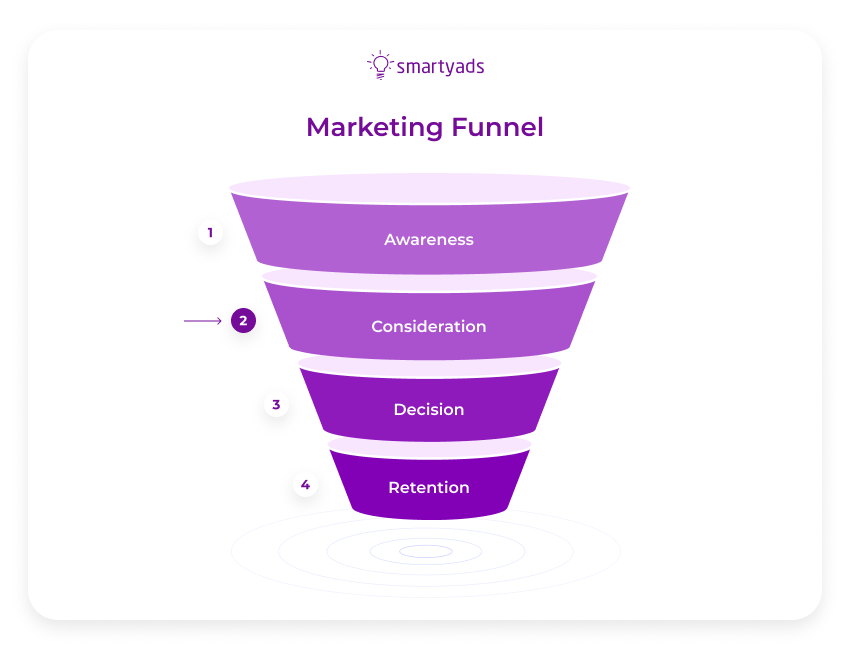
The technology is particularly effective in two types of spheres:
Spheres with a medium to long buying cycle (real estate, cars, etc.) — ads are seen by users who are in the process of choosing and making a decision. The retargeting campaign allows you to warm them up and get them to purchase faster.
Spheres with rapidly renewable demand (food, beauty services, etc.) — here you should consider the duration of the purchase cycle and show ads in anticipation of a new one.
For example, people, who get manicures, get it every 4 weeks, you can display ads to them 3 weeks after their visit to prevent them from leaving for another studio.
You can set up the retargeting audience collection and run the retargeted ad campaign in the account of the selected DPS platform.
The benefits of retargeting
Retargeting is a great addition to your advertising campaign and probably the best digital tool for customer retention and return. Let's look at the main benefits of retargeting.
Reaching interested potential customers
The most important benefit of retargeting is that you spend resources to reach already interested customers. In other words, it is the most profitable investment.
Increased brand awareness/recognition
Retargeting allows your brand to stay in front of your customers at all times. Because of it, brand awareness will constantly increase.
Efficiency
Regular digital advertising only works for a small percentage of your target audience, because it is impossible to guess if your target audience needs your brand's products right now. Retargeting, on the other hand, is already targeting interested customers, which means the conversion rate will be much higher.
Increased conversions
A logical consequence of the previous points. If we attract customers who are already interested, the conversion rate will be much higher.
Examples of retargeting
You've probably seen retargeting ads many times, but you may not have realized that they were retargeting. Retargeting ads are pretty easy to spot; they always seem a little familiar to users. Let's take a look at examples of retargeting ads to understand better how they look and work.
1) Sabri Subi: retargeting with humor
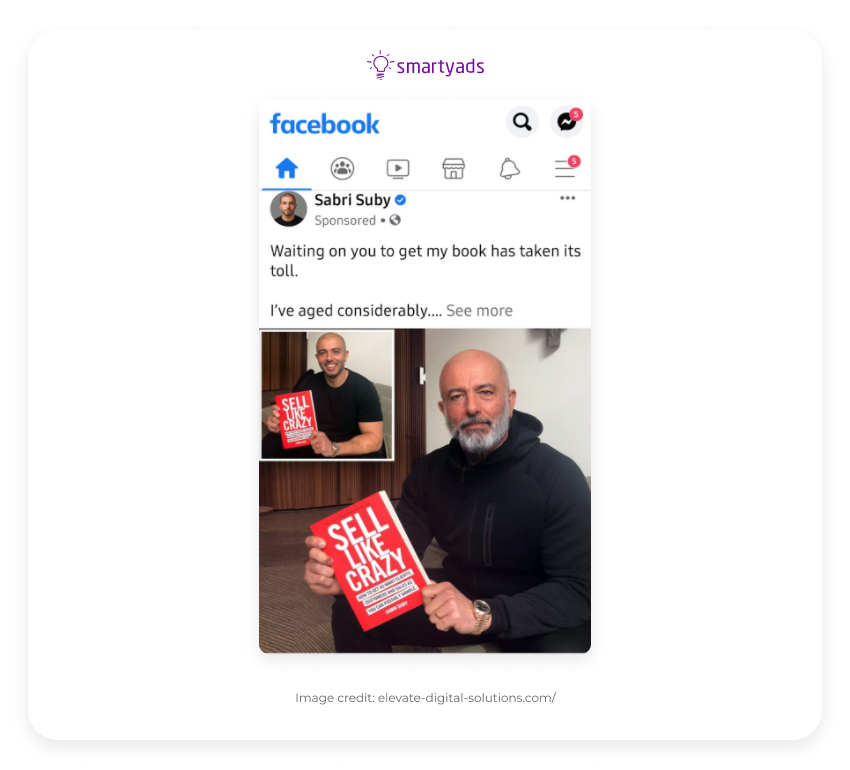
In this ad, Sabri Subi wants to sell a user a book that the user has clearly looked at or even was going to buy. Sabri himself probably thought the book wasn't being bought because he wasn't trustworthy, so he decided to lighten the mood with a joke.
When you look at this ad, you can't help but think, "Oh, it's the guy with the marketing book! Wait, how did he know?" Humor is a great way to get closer to the customer and increase trust in the brand or product.
2) J. Crew Factory: time is running out
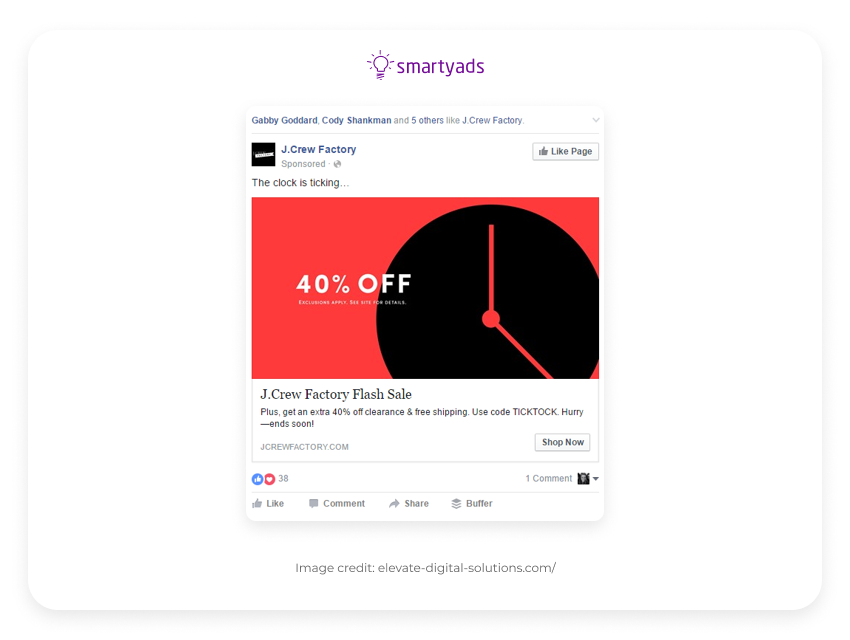
J. Crew Factory uses a well-known advertising trick; the users get the impression that they have no time at all, and if they don't make a purchase right now, then it will be too late. This technique is especially good for retargeting because if the users looked at a specific product but didn't buy it, something stopped them from purchasing it.
If we give a discount on this product and say that the discount ends in a few days or hours, they won't have time to think about the reasons that stopped them last time, and the discount becomes an additional motivation to make a purchase.
Additionally, you can familiarize yourself with useful reminder advertising examples that can be used as a part of ad campaign.

What are remarketing campaigns?
Remarketing is when you take action to re-engage customers based on their previous purchases. It's an important part of your customer retention strategy and is often done through programmatic marketing.
You can set up a monthly email remarketing list to let your customers know the latest news about the company or its products. You can also create lists that let users know about sales, discounts, or promotions related to their past purchases from you. It's called email remarketing campaigns.
Let's say you have a tech sales site. Someone who bought a smartphone may be interested in buying a case, glass, or headphones in the future. Or they might be interested in buying a charger or other products from that brand.
You can email these existing customers about tech sales and tell them about new products. If the customer hasn't made a new purchase in a while, you can offer a coupon or other promotion.
As for your sales funnel, remarketing campaigns are about bringing back people who have already completed your funnel. After making a purchase, you'll probably want to keep them interested and engaged with your company.
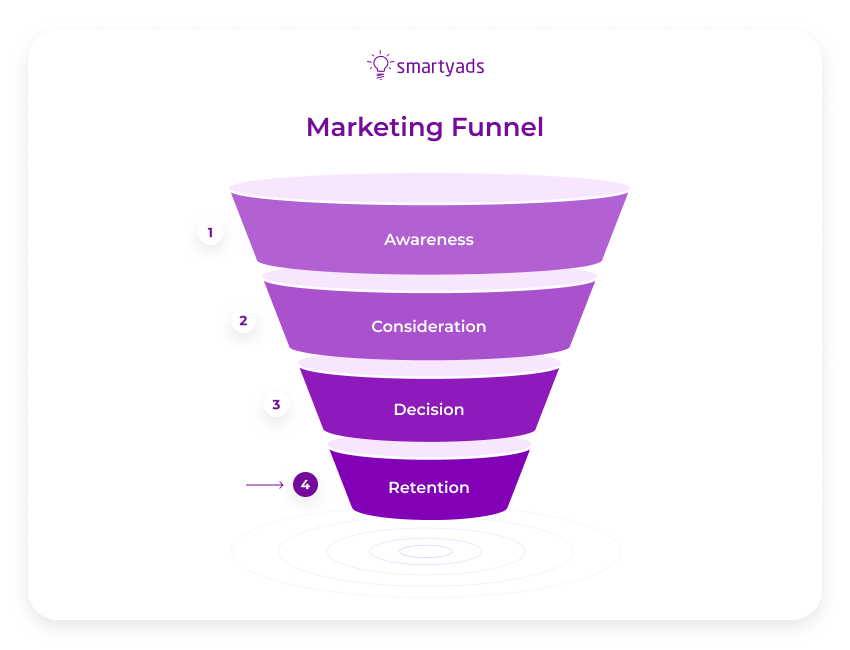
The benefits of remarketing
Remarketing is very similar to retargeting in its essence. The difference is that retargeting works with potential but interested customers while remarketing works with customers who have already made a purchase.
Therefore, the benefits of remarketing are much the same as those of retargeting.
Reaching Interested Customers
Reach potential customers who have already engaged with your brand, whether through website visits, cart additions, or ad interactions. Targeting this audience ensures your marketing efforts are directed towards receptive users, maximizing effectiveness.
Increased Brand Awareness/Recognition
Enhance brand visibility and recognition among your target audience. By repeatedly exposing them to your brand across various platforms, you establish a stronger presence in their minds, fostering trust and loyalty over time.
Efficiency
Optimize your marketing budget and resources by focusing on users who have already shown interest in your products or services. This targeted approach ensures that your advertising efforts are more cost-effective and yield higher returns on investment.
Increased Conversions
Drive more conversions by continuously engaging with potential customers throughout their online journey. By staying top-of-mind and providing relevant offers, you increase the likelihood of users completing desired actions, such as making a purchase or signing up for a service.
What businesses do with retargeting and remarketing campaigns
Warms up target audiences by constantly reminding them about the brand
This is especially important for products with a long transaction cycle, such as real estate. Buying or renting real estate is not a quick decision, so retargeting can be extremely effective here. However, you should keep track of when to stop showing ads to the user and not display them too often.
Brings back those who abandoned items in the cart and didn't place an order
You can add a link to the cart itself in the ad, as well as set up dynamic ads with items the user has reviewed.
For such advertising, email retargeting, as well as banner ads, are perfect. The user was clearly looking for the right product, perhaps if you offer them a small discount, they will choose in favor of your brand.
Tells those who have already bought something from you
Such a remarketing campaign can be set up for people who have already bought something from you. If they remain loyal to the brand, they are more likely to be interested in new products, new arrivals, or promotions from your brand.
Offers related products after the purchase
For example, if you buy wall paint, such advertising may suggest buying brushes or protective coatings, or if you buy a bed, advertising will offer the right size mattress and bed linens. Such advertising can significantly boost sales and is a great way to increase brand loyalty.
Informs about discounts and promotions
For example, if the user was interested in an item and now the price has dropped. If they are a regular customer, they may be interested in seasonal shopping.
Monthly email remarketing lists with discounts and promotions help to remind them about the brand and increase the regularity of their purchases.
Bringing people to your site
Retargeting can "drive" to your site people who have seen your ads and interacted with them in some way. This is a great tool for attracting new potential customers.
Top 3 mistakes when setting up retargeting
Sometimes retargeting instruments don't produce the results you'd expect from them. Here's why this can happen.
Wrong people
Remarketing ads with an item are displayed to people who have already bought it. For example, if the user viewed the product, but didn't place the order, but picked it up himself from the store. For the data to be more accurate, you need to combine the data of online and offline purchases by integrating the CRM system and end-to-end analytics.
Too many ads
Advertising is intrusive and shows the same product constantly and over a long period. This point isn't just about retargeting, but setting up all campaigns in general. In order not to irritate users, it is better to limit the display ad to 7-12 times a month, and let the ads only remind them of your products, rather than aggressively impose them.
Not interested audience
The audience is not segmented. You shouldn't show ads to all site visitors, some of them may stay cold. Segment the audience by their actions on the site, for example, into those who quickly left it, and those who spent a long time looking at the catalog and clicked a few product cards.
Remarketing or Retargeting: Full Comparison Table
This table summarizes the key differences between retargeting and remarketing:
| Feature | Retargeting | Remarketing |
| Targeting Method | Based on user's online behavior (e.g., cart abandonment, website visits | Focuses on users who have engaged with the brand (e.g., email subscribers, previous customers) |
| Scope | Narrow, targeting specific actions or behaviors | Broad, encompassing various marketing touchpoints |
| Audience Engagement | Targets users across the web through ad networks and platforms | Engages users through personalized emails, ads, and other channels |
| Timing | Immediate, targeting users shortly after their interaction with the site | Ongoing, nurturing relationships with customers over time |
| Conversion Strategy | Emphasizes prompting immediate action or purchase | Focuses on building long-term customer relationships and loyalty |
| Ad Formats | Display ads, social media ads, and other online ad formats | Email newsletters, personalized ads, and other direct marketing channels |
| Data Integration | Relies heavily on online user data and browsing behavior | Utilizes both online and offline customer data, integrated through CRM systems |
| Personalization | Tailors ads based on specific products or pages viewed | Customizes messages and offers based on individual user preferences and behaviors |
Retargeting vs remarketing: which to choose?
Don't choose retarget vs remarket! Since now you know what is the difference between retargeting and remarketing, you can use them equally in your digital marketing campaigns.
You can't say either one is more effective because they have different goals and work in various parts of the marketing funnel. However, both of these strategies allow you to re-engage customers and visitors in the funnel.
You should analyze what is remarketing and retargeting in term of perfomance, find out your conversion rate, and compare it to how well it's working as planned.
If something isn't working effectively enough, it's probably not the approach itself, but the campaign settings themselves.
Also, do not forget that you should not compare retargeting and remarketing campaigns with other advertising campaigns because retargeting and remarketing will always have a higher conversion rate.
To sum it up
In the dynamic world of internet marketing, there's rarely a universal solution for anything. Success hinges on factors like timing, market dynamics, global events, and your specific marketing objectives. That's why it's crucial to consider retargeting-remarketing as integral components of your strategy from the outset.
These tactics can significantly enhance your campaign's effectiveness.
Moreover, if you've previously utilized the SmartyAds DSP platform to target specific audiences, incorporating retargeting or remarketing campaigns is seamless. Leveraging your existing data, you can swiftly and effortlessly create campaigns tailored to re-engage those same audiences, maximizing your marketing ROI.
Set up effective retargeting and remarketing campaigns with SmartyAds.

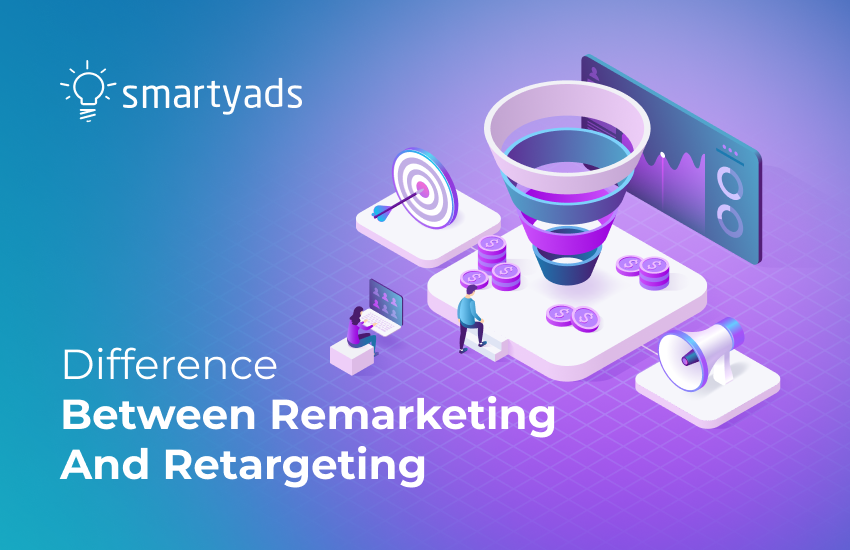
.webp)


